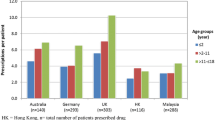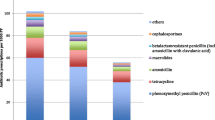Summary
The prescribing of medicines for ambulant children below 14 years of age has been compared between Tenerife (Spain) and Sweden. Data obtained from a random sample of 1327 children in a prospective study in Tenerife were compared with data from 3901 children in a Swedish survey linking diagnosis and therapy.
Upper respiratory tract infection was the main diagnosis in both countries and antibiotics was the most frequently prescribed drug group (28.2% in Tenerife and 28.8% in Sweden). Half of the children in Sweden did not receive any medication, but only 10% of those in Tenerife did not receive a prescription.
Children who received a prescription on average got 1.4 drugs in Sweden and 2.3 in Spain. Amongst the ten most commonly prescribed products in Sweden there were 11 active pharmacological principles as compared to 25 in Spain. These most frequently used preparations accounted for two thirds of all the prescriptions for children in Sweden and one third in Tenerife.
In conclusion, drugs were significantly more often used to treat paediatric outpatients in Tenerife than in Sweden. The prescribing physician in Spain also chose a wider variety of drugs and more commonly used fixed combination products.
Similar content being viewed by others
References
Kennedy DL, Forbes MB (1982) Drug therapy for ambulatory pediatric patients in 1979. Pediatrics 70: 26–29
Kramer MS, Hutchinson TA, Naimark L, Contardi R, Flegel KM, Leduc DG (1985) Antibiotic-associated gastrointestinal symptoms in general pediatric outpatients. Pediatrics 76: 365–370
Kramer MS, Hutchinson TA, Flegel KM, Naimark L, Contardi R, Leduc DG (1985) Adverse drug reactions in general pediatric outpatients. J Pediatr 106: 305–310
Sanz E, Boada J (1987) Adverse drug reactions in paediatric outpatients. Int J Clin Pharm Res 7: 169–172
Sanz E, Boada J (1988) Drug utilization in pediatric outpatients in Tenerife (Canary Islands). Eur J Clin Pharmacol 34: 495–499
Ray WA, Schaffner W, Federspiel CF (1986) Differences between female and male children in the receipt of prescribed psychotropic and controlled-analgesic drugs. A five year epidemiologic study. Med Care 24: 801–813
WHO Drug Utilization Research Group (1986) Therapeutic traditions in Northern Ireland, Norway and Sweden: Diabetes. Eur J Clin Pharmacol 30: 513–519
WHO Drug Utilization Research Group (1986) Therapeutic traditions Northern Ireland, Norway and Sweden: Hypertension. Eur J Clin Pharmacol 30: 521–525
Nordic statistics on medicines 1981–1983. Nordic Council on Medicines NLN Publication No 14–16, Uppsala, Sweden, 1985
Agenäs I, Jacobsson M, Kristofersson K (1980) Diagnos-receptundersökningen (Diagnosis and Therapy Survey), Svensk Farm Tidskr (summary in English) 84: 321
Bergman U, Sjöqvist F (1984) Measurement of drug utilization in Sweden: Methodological and clinical implications. In: Drug utilization studies: Implications for medical care. Acta Med Scand 683 [Suppl]: 15–22
SAS Institute Inc. SAS User's Guide (1985) Basics, Version 5 edition. Cary NC: SAS Institute Inc. p 1290
Textbook of pediatrics. Nelson W, Vaughan V, McKay I, Behrman R (ed). Eleventh edn WB Saunders, Philadelphia, 1979
Drug treatment. Principles and practice of clinical pharmacology and therapeutics. Ed by Avery GS. Second ed, Adis Press, New York, 1980
Gold R (1985) Pediatric clinical pharmacology in infectious diseases. In: MacLeod S, Radde I (eds) Textbook of pediatric clinical pharmacology. PSG
Nelson ID (1980) Antimicrobial drugs. In: Yaffe S (ed). Pediatric pharmacology. Therapeutic principles in practice. Grune and Stratton, New York
Dbronic L, Beni C, Camela B, Ezpeleta A, Castell E (1984) El uso de los antibióticos en la asistencia primaria en Barcelona. Med Clin (Barcelona) 82: 567–571
Editorial (1987) Bacterial pharyngitis. Lancet 1: 1241–1242
Rylance G (ed) (1987) Drugs for children. WHO, Copenhagen, pp 55–79
Inskränkt indikation för Trimetoprim + sulfa (Limitation of the indication for trimethorpim + sulfa). Information från socialstyrelsens läkemedelsavdelning (Information from the Department of Drugs, National Board of Health and Welfare in Sweden) 1987: 3
Mandel EM, Rockette HE, Bluestone CD, Paradise JL, Nozza RJ (1987) Efficacy of amoxicillin with and without decongestant-antihistamine for otitis media with effusion in children. N Engl J Med 316: 432–437
Farmaindustria (1987) La industria Farmaceutica en cifras. Farmaindustria, Arista, Madrid (ed) pp 1–17
Dukes G (1985) The effects of drug regulations: A survey based on the European studies of drug regulation. MTP Press Ltd, Lancaster
Svensk läkemedelsstatistik 1985 (Swedish Drug Statistics, Annual publication). National Corporation of Swedish Pharmacies, Stockholm, 1986
Author information
Authors and Affiliations
Rights and permissions
About this article
Cite this article
Sanz, E.J., Bergman, U. & Dahlström, M. Paediatric drug prescribing. A comparison of Tenerife (Canary Islands, Spain) and Sweden. Eur J Clin Pharmacol 37, 65–68 (1989). https://doi.org/10.1007/BF00609427
Received:
Accepted:
Issue Date:
DOI: https://doi.org/10.1007/BF00609427




